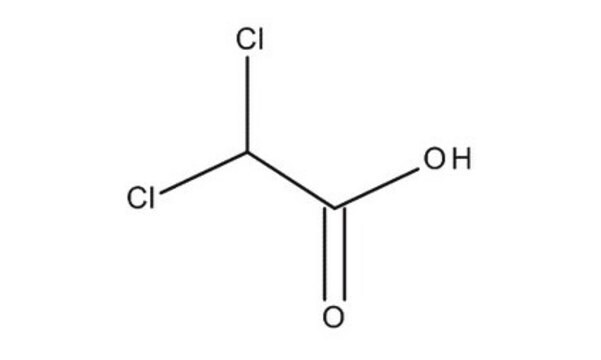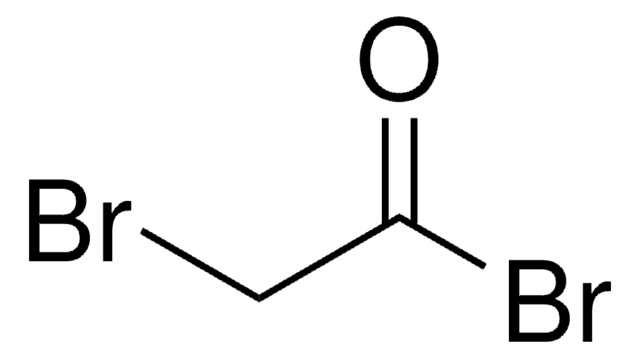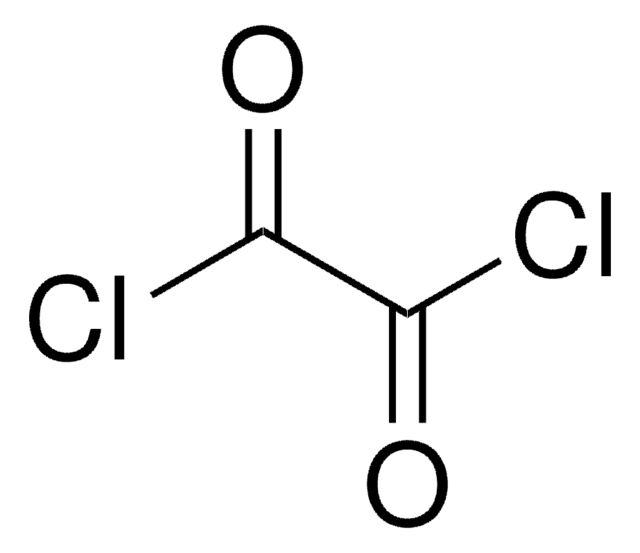추천 제품
애플리케이션
Dibromoacetic acid can be used as a reactant:
- Forthe stereoselective synthesis of (E)-α, β-unsaturated carboxylic acidsby samarium diiodide (SmI2) catalyzed reaction with aldehydes.
- Tosynthesize sodium bis(2-pyridylthio)acetate ligand by reacting with 2-mercaptopyridinein the presence of NaOH.
기타 정보
remainder mono-bromoacetic acid
신호어
Danger
유해 및 위험 성명서
Hazard Classifications
Acute Tox. 4 Dermal - Acute Tox. 4 Inhalation - Acute Tox. 4 Oral - Aquatic Chronic 3 - Eye Dam. 1 - Skin Corr. 1B
Storage Class Code
8A - Combustible corrosive hazardous materials
WGK
WGK 3
Flash Point (°F)
235.4 °F - closed cup
Flash Point (°C)
113 °C - closed cup
개인 보호 장비
Eyeshields, Faceshields, Gloves, type P3 (EN 143) respirator cartridges
이미 열람한 고객
Wenbo Jiang et al.
Metabolic brain disease, 32(6), 2009-2019 (2017-08-28)
Dibromoacetic acid (DBA) exsits in drinking water as a by-product of disinfection as a result of chlorination or ozonation processes. Hippocampus and pre-frontal cortex are the key structures in memory formation and weanling babies are more sensitive to environmental toxicant
Eric R V Dickenson et al.
Environmental science & technology, 42(9), 3226-3233 (2008-06-05)
While it is known that resorcinol- and phenol-type aromatic structures within natural organic matter (NOM) react during drinking water chlorination to form trihalomethanes (THMs), limited studies have examined aliphatic-type structures as THM and haloacetic acid (HAA) precursors. A suite of
N M Weber et al.
Toxicological sciences : an official journal of the Society of Toxicology, 89(1), 325-330 (2005-10-14)
Water disinfection by-products, such as dibromoacetic acid (DBA), are formed when drinking water is treated with chlorination, bromination, or ozonation. Epidemiological studies have linked these byproducts to adverse effects in humans such as cancer, developmental defects, and reproductive toxicities. DBA
Lianhui Tao et al.
Toxicological sciences : an official journal of the Society of Toxicology, 82(1), 62-69 (2004-09-03)
Dibromoacetic acid (DBA) is a drinking water disinfection by-product. Its analogs, dichloroacetic acid (DCA) and trichloroacetic acid (TCA), are liver carcinogens in rodents. We evaluated the ability of DBA to cause DNA hypomethylation, glycogen accumulation, and peroxisome proliferation that are
Ronald L Melnick et al.
Toxicology, 230(2-3), 126-136 (2006-12-13)
Dibromoacetic acid (DBA) is a water disinfection byproduct formed by the reaction of chlorine oxidizing compounds with natural organic matter in water containing bromide. Male and female F344/N rats and B6C3F(1) mice were exposed to DBA in drinking water for
자사의 과학자팀은 생명 과학, 재료 과학, 화학 합성, 크로마토그래피, 분석 및 기타 많은 영역을 포함한 모든 과학 분야에 경험이 있습니다..
고객지원팀으로 연락바랍니다.














